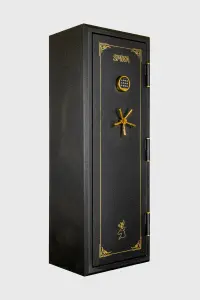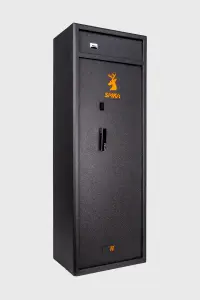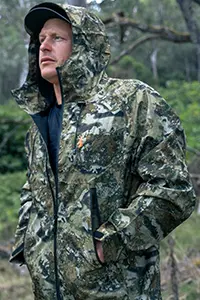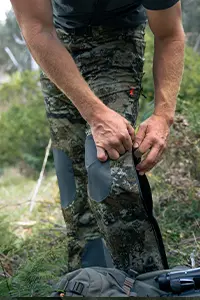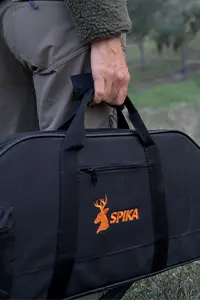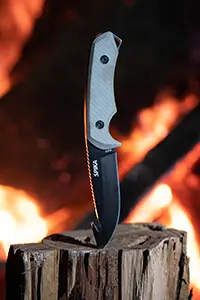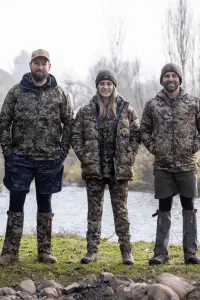STATE REGULATIONS
Any person in possession of a firearm must take all reasonable precautions to ensure the firearm is kept safely, is not lost or stolen and does not come into the possession of an unauthorised person. In addition to this general safe keeping requirement, there are specific legislative requirements for the safe keeping and storage of firearms that you should familiarise yourself with. We have listed out requirements below, that are correct as of July 2023, however it is your responsibility to check with your local laws to make sure you are meeting the required regulations.
ACT
Detailed State Requirements: Click Here
Category A and B firearms (up to and including 10 firearms in total)
- The firearms must be stored in a metal lockable container and the firing mechanisms must be stored in a separate lockable metal drawer or container that may be external or internal to the metal lockable container; or
- The firearms must be stored in a security container that is constructed of a recognised hardwood and lined with steel sheeting, the door of which is fitted with metal hinges and either an appropriate deadlock; or 2 sliding bolts fitted with padlocks of an appropriate strength.
- The container must be bolted to the floor/wall or both with a minimum of two suitable anchor bolts in order to prevent its easy removal (unless the mass of the container when empty is 150 kilograms or more when empty).
Category A and B firearms (in excess of 10 firearms in total), Category C, D and H
- The firearms must be stored in a metal or concrete or brick safe.
- For a metal safe: Must be constructed of structural grade mild steel that conforms with AS/NZS 3678:1996 grade 250 and is not less than 3mm thick and be constructed with continuous welding of all edges.
- For a safe other than a metal safe be constructed of reinforced concrete, double brick or reinforced besser blocks that are not less than 140mm thick.
- All safes must be fitted with a door:
- Constructed of structural grade mild steel (that conforms with Australian Standard 3678:1996 grade 250 and is not less than 3mm thick) and that is swung on either concealed pivots or externally mounted sealed-end hinges welded to the door and body of the container, and that is flush fitting with a clearance around it of no more than 1mm; and
- If the door is hinged - have a fixed locking bar or dogging bolts welded to the inside face of the door near the hinge edge that engages or engage in a rebate in the container body when the door is closed; and
- Be fitted with a 5-lever key deadlock or a locking mechanism that provides at least equivalent security; and
- Be constructed with a full length steel rebate welded to the side of the container body, the locking edge of which will receive the deadlock of the locking mechanism.
- A locking mechanism must be securely fixed to the rear face of the door of the container by retaining screws and a metal strap overlapping, or enclosing, the locking case with each end welded to the rear door face.
NSW
Detailed State Requirements: Click Here
Category A & B
Section 40 of the Firearms Act 1996 (the Act) provides mandatory minimum requirements for the safe keeping and storage of firearms held under a Category A and B licence as follows:
- When any firearm is not actually being used or carried, it must be stored in a locked receptacle of a type approved by the Commissioner of Police and that is constructed of hard wood or steel and not easily penetrable
- If the receptacle weighs less than 150 kilograms when empty, it must be fixed in order to prevent its easy removal
- The locks of such a receptacle must be of solid metal and be of a type approved by the Commissioner
- Any ammunition for the firearm must be stored in a locked container of a type approved by the Commissioner Ammunition may be kept in the receptacle with the firearms, but must be kept in a separate locked container within the receptacle
Category C, D & H
Section 41 of the Act provides mandatory minimum requirements for the safe keeping and storage of firearms held under a Category C, D and H licence as follows:
- When a firearm is not actually being used or carried, it must be stored in a locked steel safe of a type approved by the Commissioner, that cannot be easily penetrated
- The safe must be bolted to the structure of the premises where the firearm is authorised to be kept
- Any ammunition for the firearm must be stored in a locked container of a type approved by the Commissioner
- Ammunition may be kept in the safe with the firearms, but must be kept in a separate locked container within the safe
QLD
Detailed State Requirements: Click Here
Category A, B, C, E & M (30 or fewer)
In a locked container constructed of solid steel or solid timber, and securely fixed to the frame or floor of a permanent building if the container weighs less than 150kg. Container must be kept locked with a sturdy combination lock, keyed lock or keyed padlock.
Category D, H & R (30 or fewer)
In a solid steel container, bolted to the frame or floor of a permanent building. Container must be kept locked with a sturdy combination lock, keyed lock or keyed padlock.
SA
Detailed State Requirements: Click Here
New firearms legislation (including storage requirement updates) came into effect on 1 July 2017. An outline is provided below, however comprehensive updates can be found here Click Here
| Aggregate number of firearms | Minimum security level and requirements |
|---|---|
| 1-19 firearms (category A or B firearms only) | Level 1 safe; or Prescribed safe if licence holder on 1 July 2017 (needs written confirmation of Registrar) |
| 1-19 firearms (where at least one firearm is a category C, D or H firearm) | Level 2 safe; or Level 1 safe (needs written confirmation of Registrar); or Prescribed safe if existing licence holder on 1 July 2017 (needs written confirmation of Registrar) |
| 20-34 firearms (firearms of any category, but must be less than 30 category H) | Level 2 safe with the premises installed with a working CCTV or working intruder alarm system. |
| 35-49 firearms (firearms of any category, but must be less than 30 category H) | Level 2 safe with the premises installed with a working CCTV system and a working intruder alarm system. |
| 50+ firearms of any category; or 30+ category H firearms | Strongroom with the premises installed with a working CCTV system and a working intruder alarm system. |
Level 1 Safe
- Minimum 2mm thick steel sides
- Minimum 2mm thick steel door
Level 2 Safe
- Minimum 3mm thick steel sides
- Minimum 3mm thick steel door
Minimum Specifications
Safes and strongrooms are required to be built to minimum specifications (e.g. certain locks and hinges required) or in some other manner approved by the Registrar – for further information refer to clauses 2 and 11, Schedule 1 of the Firearms Regulations or the Firearms section on SAPOL’s website.
Firearms and ammunition storage location
Unless approved otherwise by the Registrar, firearms and ammunition must be stored at your principal place of residence; or if you possess the firearm for the purpose of your business, your principal place of business. Written advice to the Registrar is required prior to a change of location.
Ammunition storage
Ammunition must be stored separately from firearms in a strongly made timber, metal, fibreglass or injection moulded hard thermoplastic container with a substantial locking and hinge mechanism.
TAS
NOTE: New Storage Laws in Tasmania commence 4 December 2017 – for more information on these changes and what they mean for you. Click Here
Category A & B
According to the Tasmanian Firearms Services webpage; storage of Category A∓B firearms must follow the below requirements.
Your safe’s construction must conform to one of the following:
- Safe is made from concrete OR
- Safe is made from metal at least 2mm thick (manufacturer’s paperwork or website should tell you).
Your safe must be hard to penetrate; Strong with good quality construction and materials
Your safe must be free from weak points like rusty parts or leverage points around the door / or the safe itself.
The hinges of your safe must conform to one of the following:
- The hinges are inside the safe when the door is closed OR
- If the door is locked and someone removes the hinges, is the door still unable to be opened?
Your safe’s weight or fixing must conform to one of the following:
- Safe weighs 150kg or more OR
- Safe is bolted or screwed down at least 4 times. For example:
- 4 times to wall or floor; or
- 2 times to a wall and 2 times to floor
Click Here To Read The Full Safe Requirements >>
Category C, D & H
According to the Tasmanian Firearms Services webpage; storage of Category C, D ∓ H firearms must follow the below requirements.
Your safe’s construction must conform to one of the following:
- Safe is made from concrete OR
- Safe is made from metal at least 3mm thick (manufacturer’s paperwork or website should tell you).
Your safe must be hard to penetrate; Strong with good quality construction and materials
Your safe must be free from weak points like rusty parts or leverage points around the door / or the safe itself.
The hinges of your safe must conform to one of the following:
- The hinges are inside the safe when the door is closed OR
- If the door is locked and someone removes the hinges, is the door still unable to be opened?
Your safe’s weight or fixing must conform to one of the following:
- Safe weighs 150kg or more OR
- Safe is bolted or screwed down at least 4 times. For example:
- 4 times to wall or floor; or
- 2 times to a wall and 2 times to floor
WA
Detailed State Requirements: Click Here
- A person entitled to possess firearms or ammunition of any kind is to ensure that the firearms or ammunition are stored in accordance with this regulation.
- Firearms and ammunition are to be stored in a locked cabinet or container that at least meets the specifications described in Schedule 4 or in such other way as is approved.
- A cabinet or container that can be unlocked with a key is to be regarded as unlocked if the key is left in the lock or is otherwise accessible where the cabinet or container is located.
- A magazine is not to contain any ammunition when it is stored.
- Ammunition is not to be stored in a cabinet or container in which a firearm is stored unless the ammunition is in another locked metal container in which no firearm is stored and which is securely affixed so as to prevent its removal from the cabinet or container.
- The requirements of this regulation are in addition to, not instead of, any requirements under the Dangerous Goods Safety Act 2004 which can be found in the Related Information below.
VIC
Detailed State Requirements: Click Here
Category A, B, C, D & H
From 30 August 2022, the following must be met to ensure compliance with the law:
- Firearms must be stored in a purpose-built steel storage receptacle
- The steel must be of a thickness of at least 1.6mm (which complies with Australian/New Zealand Standard 1594:2002).
- If the receptacle weighs less than 150 kilograms when it is empty, it must be bolted to the structure of the premises.
- The receptacle must be locked with a lock of sturdy construction when the firearm is stored in it.
NZ
Detailed Requirements: Click Here
All firearms licences are subject to conditions that require the safe and secure storage of their firearms. There are additional conditions that apply to endorsement holders in relation to pistols, prohibited firearms, prohibited magazines and restricted weapons.
JOIN TEAM SPIKA AND GET UPDATES FOR THE BEST HUNTING GEAR AND NEW RELEASES. SIGN UP
